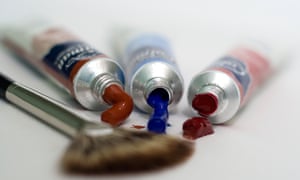Doctors couldn’t diagnose my mental health problems. But then they saw my art

Ispent nearly 20 years of my life mentally unwell, detained in various psychiatric hospitals while doctors argued about what was wrong with me. I received numerous conflicting diagnoses which I would add to my growing collection, still feeling unheard and misunderstood.
While I was in Addenbrooke’s hospital in Cambridge, I would paint how I was feeling. Suddenly, I would begin to splash paint around my room, on large pieces of paper placed on the floor. It was very messy but incredibly cathartic. I would interpret my pain and torture, and create dashing, blurred, abstract compositions or wonky self-portraits. There seemed to be a metaphysical transition from my illness to the painting. I was never very good at drawing objects or people accurately, but these works would directly and precisely express my illness.
In hospital, painting eased the wounds by allowing me to concentrate on something else. It set me free. The abstract images I created embodied my feelings, and gave me a voice.
One drawing expressed the tactile hallucinations I was undergoing. It felt like barbed wire was being wrapped around my throat. I had the physical sensation that I was being strangled; I felt very close to death. I drew this very intense, agonising and asphyxiating experience, and showed it to the consultant and medical team at the hospital.
The consultant peered over my drawing, and analysed it from a medical (rather than aesthetic) perspective. He correlated the sharp points in the picture as indicative of a certain form of tactile hallucination, and also said that the dark, despondent image was evidence of a mood disorder. In this way, the medical team were able to read my painting, reach their formal diagnosis of schizoaffective disorder, and medicate me accordingly.
My consultant was now able to diagnose and treat me, in direct correspondence with what he saw in my art. This was a life-changing moment. At last, I was understood. My art could express what was unspeakable; it offered me language when I was silenced by my misery. All I had to do was pick up a brush, dab it in some paint, and then let it go. Thoughts stopped, and the intrinsic power of creativity and the imagination took me to places where my conscious mind did not dare go. With no predetermined intention or direction, the paintings evolved by themselves. Then I would take the finished article to the nurses’ office, or to my ward round, for a formal medical viewing.
The medical team took my artworks very seriously. On my formal care plan, under the list of prescribed medications I took to treat my illness, the doctor wrote “painting”. When I was feeling upset or unsafe, painting was my go-to coping mechanism and support. It calmed me down and gave me a voice; I could express what I couldn’t say.
I decided to become an arts in health researcher and practitioner. I did a PhD at Cambridge University, and my thesis (which became a book – Making sense: art practice and transformative therapeutics) considered how art can have a diagnostic and medicinal effect. I had to prove that art could help people make sense of their lives and initiate healing. My recovery, using art, was the crux of my thesis. I had to recover, to prove my thesis and complete my PhD. Would art be able to save me?
Eventually, it did. I work in the field of arts in health and am starting an arts on prescription service in my local area, Buckinghamshire. Now I am well and happy, with the brand-new life I have created. I still paint every day, and it brings me a great deal of pleasure.
[“source=theguardian”]



